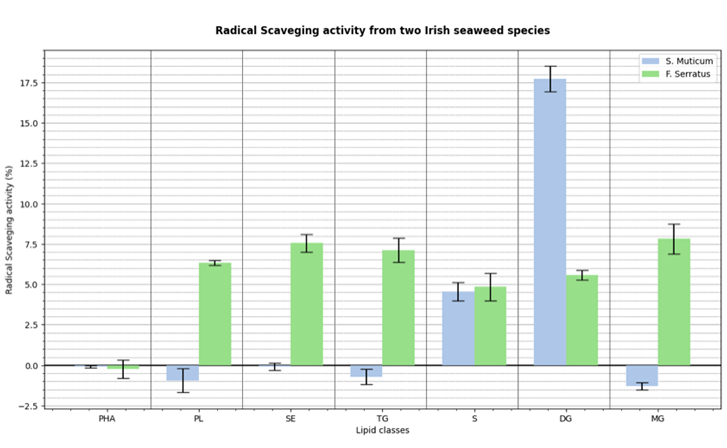Paper Authors and Title
Julia Lach (Atlantic Technological University), Shane O’Reilly, “Antioxidant Bioactivity of Seaweed Lipid Extracts”
Abstract
Seaweeds are a wide spread natural resource found at beaches and along the coast. Ambitions for a sustainable, blue bio-economies have created renewed interest; and seaweed offers the potential to meet this need. Potential benefits of seaweed are focused on bioactivity that includes antitumoral, antibacterial, antioxidant and anticancer. Bioactivity, ultimately derived from biosynthetic natural products such as proteins, lipids, minerals and vitamins.
This study was conducted to test the antioxidant activity of crude lipid extracts and lipid classes after fractionation from Sargassum Muticum (S. Muticum), Fucus Serratus (F. Serratus), and Laminaria Digitata (L. Digitata), sampled from Irish waters. Antioxidant activity, more specifically radical scavenging activity (RSA), was evaluated using the established 2-diphenyl-1-picrylhydrazil (DPPH) radical scavenging assay. Crude extracts of 30 mg and 100 mg from F. Serratus yielded RSA of 3.84% and 15.8%, respectively. F. Serratus (%) RSA data were significantly higher than S. Muticum (%) and L. Digitata (%). After Fractionation into specific lipid classes, it was highlighted that S. Muticum RSA was primarily related to the presence of: sterols (4.56% RSA) and diacylglycerols (17.7% RSA), while F. Serratus RSA was broadly distributed across all lipid classes with the highest being monoglycerides, (7.83% RSA).
This study highlights the potential of antioxidants derived from seaweed extracts which could be incorporated into human diets. However it is evident that further research and investigations could contribute to a more comprehensive perspective on antioxidant activity from lipid extracts.
Figure 1. Comparison of Radical Scavenging Activity (%) of S.Muticum lipid fractions (blue) and F.Serratus lipid fractions (green); PHA= polvhydroxvalkanoate, PL= polar lipids, SE= steryl esters, TG= triglycerides, S= sterols, DG= diacylglycerols and MG= monoglycerides.
Poster
Download and view Julia Lach’s poster.

